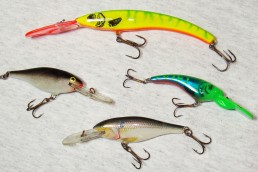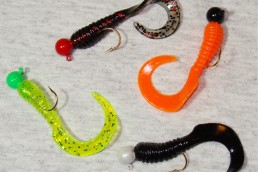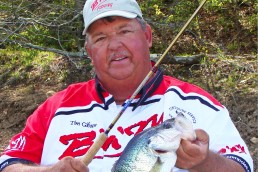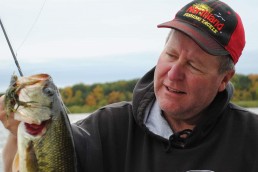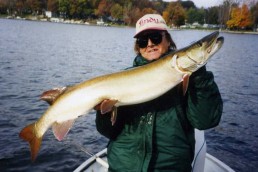Target Indiana’s Fall Saugeyes
SHARE THIS POST
Fall is a magical time of year. The weather cools down, the leaves change color and many species of fish really put on the feedbag. This last burst of excellent open-water fishing is accompanied not only by cooler, more pleasant weather, but also by less crowded lakes. Lines at the boat ramp are generally a thing of the past, after Labor Day. Luckily, the fishing isn’t affected. At times, it can be red hot. The only tough decision is figuring out where to fish; or, possibly, even what to fish for.
Although good fishing abounds in Indiana for everything from bluegills to bass to catfish, one species that is often overlooked by anglers is the saugeye. Many Hoosiers have never heard of a saugeye, and even fewer have caught one. Saugeyes are a hybrid species, the result of crossing a male sauger with a female walleye.
In general, saugeyes look very similar to walleyes. They often have faint blotches on their sides (similar to saugers), and they have a white streak on the lower edge of their tail. One easy way to identify them is that they do not have a white corner on the lower lobe of their tail like a walleye.
Where can you find a population of hungry saugeyes in Indiana? Since they are a hybrid fish, the only way to find them is to fish a lake where they have been stocked by the Department of Natural Resources (DNR). One of those lakes is Sullivan Lake, near the town of Sullivan.
Setting out for Sullivan saugeyes
Sullivan Lake is located near the southwestern border of Indiana, southwest of Shakamak State Park. Although this lake is known as a very good fishing spot for crappies, bass and other fish, it is also home to a large population of feisty saugeyes.
When asked how Sullivan’s saugeye population was faring, DNR Fisheries Chief Brian Schoenung replied that it was very strong. “In the surveys that we did in the past, we caught saugeye up to 25.5 inches in length,” he said. “Those fish probably weighed 6 or 7 pounds, and there are quite a few fish over the 14-inch limit. They are really growing well out there.”
According to Schoenung, “Most of the saugeyes are caught incidentally while people are fishing for crappies. If you can fish down through the crappies, you can catch saugeyes,” he said. Fishermen who are specifically targeting saugeyes often troll minnow-imitating crankbaits or bounce large jigs off of the points out in the lake.
Are you enjoying this post?
You can be among the first to get the latest info on where to go, what to use and how to use it!
Currently, the DNR is stocking approximately 50 saugeyes per acre at Sullivan. In the past, state biologists experimented with walleye stockings, here, too. Schoenung explained that, way back in 1995, the stocking program was switched from saugeye to walleye to see if the walleyes would do as well as the saugeyes. The stocking rate was also switched from 50 to 100 fish per acre, but the test was unsuccessful.
“We did a creel survey in 1998 and the results were unflattering, to say the least,” he said. “So, we switched back to saugeyes in 1998. And, we increased the stocking rate to 100 fish per acre, which was twice what it was in the past. We had a successful fishery before, so now it’s even more successful, with lots of hungry saugeyes out there.”
Stocked up and ready to catch!
In 2010, more than 30,000 fingerling saugeyes were stocked in Sullivan Lake, which equaled a stocking rate of 66.7 fish per acre. In four of the last five years (up to that point), an additional 275,000 surplus saugeye fry were also stocked, per year, in the springtime. Although fry do not survive as well as fingerlings, they still make a good contribution to the population.
DNR fisheries biologists conducted additional fish surveys at Sullivan Lake. They found that the saugeye population was still flourishing. According to District 5 Fisheries Biologist Dave Kittaka, those surveys yielded saugeyes ranging in size from 8.5 to 25.1 inches in length. There were also 22 young-of-the-year (YOY) saugeyes collected at a catch rate of 11 fish per hour. “The success criterion for walleye is a fall catch rate of 7 YOY per hour,” stated Kittaka. So, Sullivan’s catch rate was really good.
The most recent survey showed that there were five different year-classes of saugeyes in the lake (including YOY), which proves that the yearly stockings continue to be successful. Saugeye growth is also very good at Sullivan. Most fish reach legal size (14 inches) after one year.
Now that October is here, it is time to try something new. Forget about chasing the same old fish this fall. Get out there and catch a few tasty saugeyes. Launch your boat at Sullivan Lake, this fall, and you may just have the lake to yourself. But watch out—you might get hooked on these toothy hybrids!
MWO
SHARE THIS POST
Did you enjoy this post?
You can be among the first to get the latest info on where to go, what to use and how to use it!
Tom Berg
A lifelong outdoorsman and award-winning outdoor writer and nature photographer, Tom Berg has been the Executive Director/Treasurer of the Hoosier Outdoor Writers group for the past 14 years. When he is not writing, he would rather be outside fishing, hunting or trapping than doing just about anything else.
